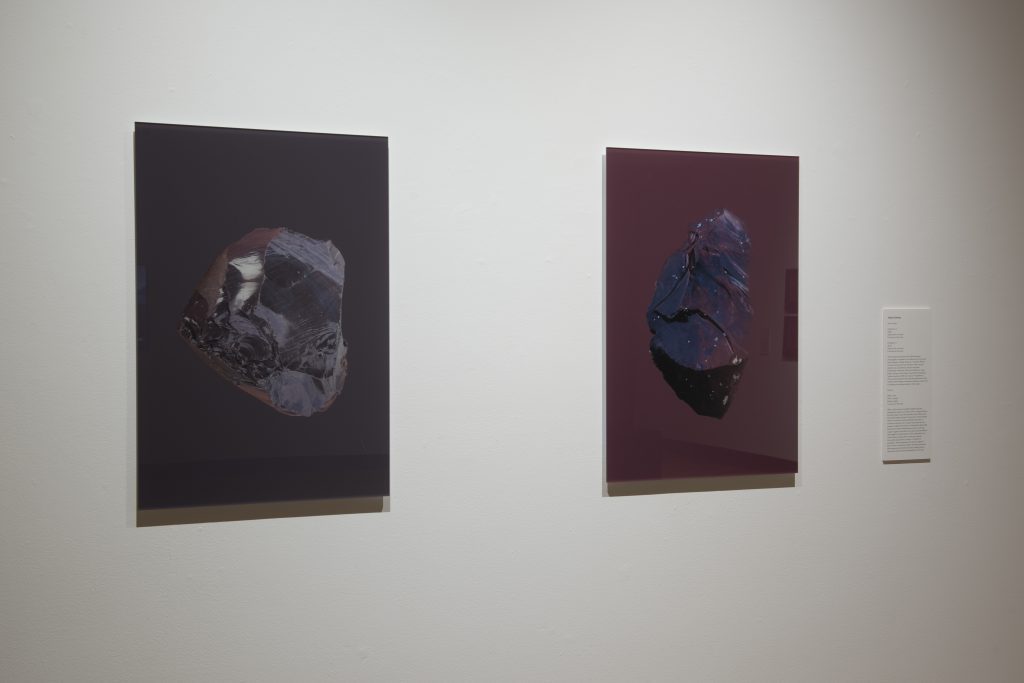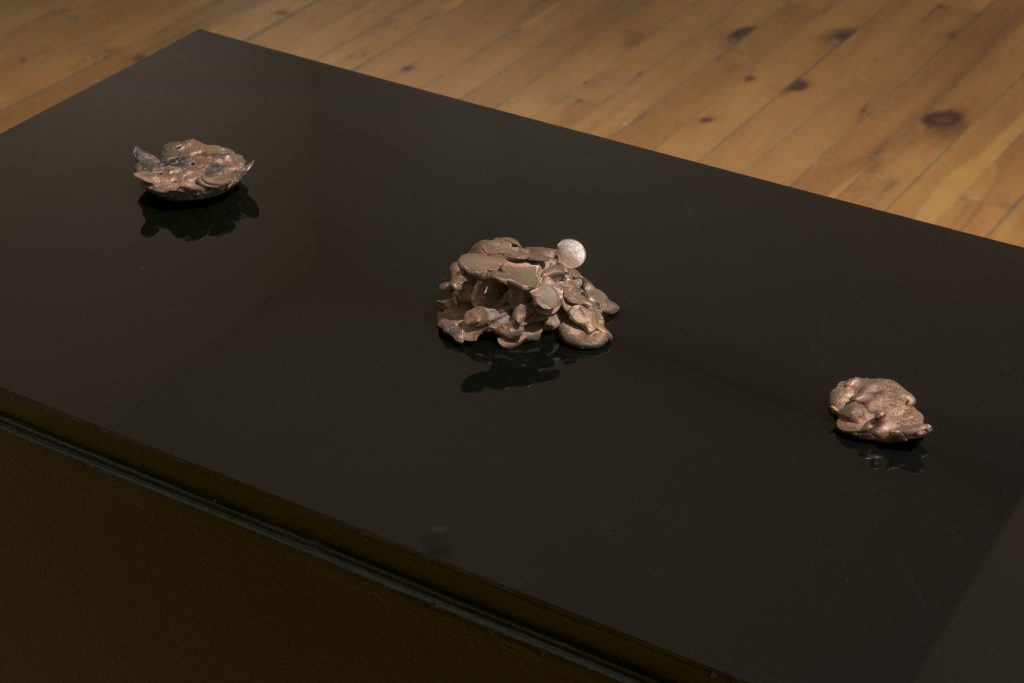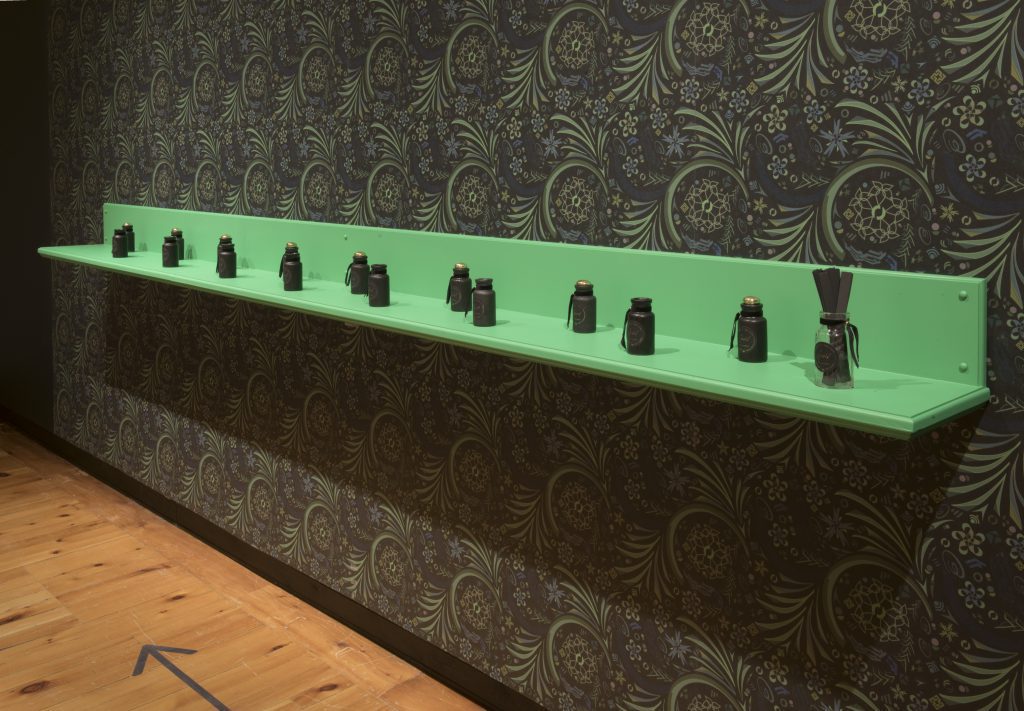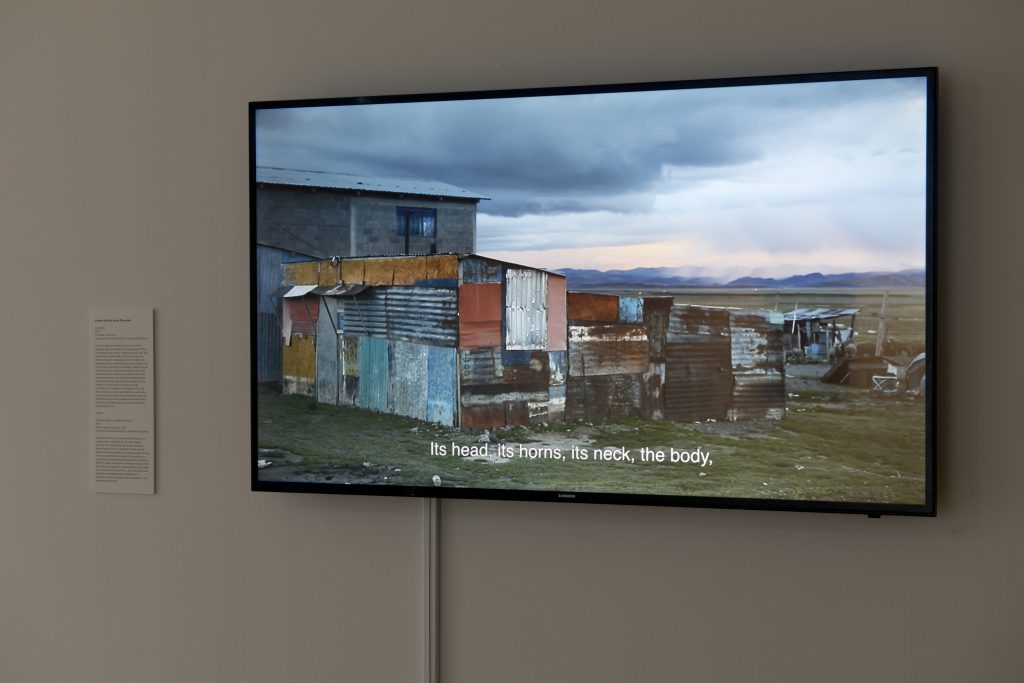Grounding at the Art Gallery of Guelph
20 October 2021
By Juilee Raje
While a second provincial lockdown was looming around the corner last winter, my mother and I managed to squeeze in one last visit to the Art Gallery of Guelph. The thrill of getting to see a few exhibitions in person (rather than the tiresome ordeal of clicking through virtual shows online) was much needed. We were restless to get out of the house, the days melting together more insistently than ever. Though I revisited the gallery a few times after, and with different people, this exhibition still sticks prominently in my mind as “the one where we tried to experience an olfactory installation while wearing masks.”
Grounding, curated by Maya Wilson-Sanchez, presented works from four multidisciplinary artists that responded to persistent and destructive Canadian interventions of extracting natural resources in the Americas—helping to visualize deep losses and the damage done to culture and Indigenous sovereignty, human rights, and the environment. Warren Cariou (Métis/European), Tsēmā (Tahltan), Ximena Garrido-Lecca (Peruvian), and Dana Prieto (Argentine) pulled communal knowledge out of the peripheries and centred it within their practices of working with materials derived from the very soil of the places they call home. It was an exhibition that prompted almost as many questions and mysteries as the answers it offered, alternating between taking deep plunges into the ground and keeping a slightly perplexing distance from the viewer.
The gallery inevitably closed its doors to the public during lockdown, and I revisited the exhibition in my mind while writing about it in the following months. The ecopolitical undertones behind each piece came into clear view when contrasted with everything happening outside of the room in which they were temporarily housed. These days some may find it difficult to keep track of time, but, arguably, multiple timelines matter drastically more; for instance, the global health crisis runs parallel to the tensions regarding environmental concerns in North America that are coming to a head, boiling over, hardening, and brewing anew.
Grounding’s strength lay in the exceptionally strong connections displayed between sourced materials and the technical developments of photography, installation, sculpture, and video—the layers of rich meaning behind each work formed convincing ties to the global, political, and social crises to which they responded. The sensitive dedication given to location and justice, however, tends to fall to abstraction when the bigger questions arise: who can we hold accountable now (after implicating our complacent selves), and what is within our reach?

For two years, Coastal GasLink has forged ahead with its large-scale project to build a 670-kilometre tar sands pipeline through unceded Indigenous territories, rightfully meeting with resistance from Wet’suwet’en hereditary Chiefs and land defenders, whom the Royal Canadian Mounted Police has attempted to intimidate through unnecessary arrests and violence. More recently, the East Coast saw an alarming display of racism against Mi’kmaq fishers on St. Mary’s Bay in Nova Scotia, when lobster pounds were set alight by a mob of settlers.
Tsēmā and Warren Cariou’s works responded to the pipeline project’s ecological devastation on land around Alberta and Tahltan First Nation territory (British Columbia), where they observed the toxic bitumen deposits that are characteristic of tar sands mining sites. Ximena Garrido-Lecca and Dana Prieto surveyed the contamination and reckless salvages of open-pit mining sites in Peru and Argentina, pulling into focus the emotional, sensory aftermath of colonial powers trudging into unceded territories. Grounded by his curiosities of photographic practices and histories, Cariou salvaged the material from banks of the Athabasca River to develop Petrographs (2016), through a process of petroleum-photography inspired by French inventor Nicéphore Niépce’s pioneering 1826 experiments with bitumen-based photography. Every step in the lengthy, experimental process of creating a petrograph is reminiscent of the ecological devastation from which the material is sourced, whether through its toxic smells or the griminess that is present when the material changes forms.
In the exhibition, the final works were arranged symmetrically on the wall as thin golden plates. This allowed audiences “to see the world quite literally through a film of heavy crude oil,” as Cariou states on his website.1 The reflective plates contained hidden images that can only be viewed when approached from certain angles. This invited the viewer to play with the relationship between the petrograph and their lines of vision until they were able to discern something—darkened landscapes, unidentifiable buildings cropped into artistic compositions, or cityscapes on the horizon overlooking bodies of water. This technique implicates the viewer, regardless of their relationship to the oil industry—asking us to consider our action or complacency in the formation of Canada’s colonial economies through our own reflection in the landscapes.
Parallel to this line of thought, these reflections also created more evasiness about the timelines and culprits behind their existence—unable to tell when these landscapes were captured, how these sites differed after the damage, or the possibility of recurrence, for example. Enraptured by the solipsistic beauty of the hardened form, trying to catch the images through the illusion, a question arose: Are we looking with nostalgia at something that will cease to duplicate itself in the future, or looking to an alternate value system with acceptance that the colonial petroleum industry will always exist?
Tahltan First Nation artist Tsēmā similarly draws attention to raw materials of bitumen and copper, and how their uses differ between colonial and Indigenous value systems. Around the same time that Grounding was presented at the Art Gallery of Guelph, writer Steph Wong Ken recalled a previous exhibition featuring Tsēmā, Black Gold at the Untitled Art Society in April of 2019, describing the artist’s practice in the context of how art responds to trash, and the economies formed through increased consumption during the pandemic. Tsēmā outlined the Tahltan community’s use of the natural substance of obsidian in weaponry, extracted from the ground and used in modest quantities, and how sustainable use of the material has now been replaced by the petroleum industry’s highly toxic process of bitumen creation.
In Grounding, Tsēmā further pushed the critique of ecological damage that occurs when resources are extracted from the earth in vast quantities without offering a replenishment in return. What is Left (2015), a sculpture in which gleaming nuggets of melted copper perched atop black plinths, commenorated the now-obsolete Canadian currency of pennies. A certain energy emanated from the work, making it feel as though the copper was melting, becoming formless, and returning to its original state—disqualifying itself from colonial identification. It was a subtle yet steady gesture, suggesting that a shift towards abolition comes through moving backwards: gaining riches by letting them slip through our fingers and back into the earth.
Similarly looking towards the future, but pausing to absorb the sorrow of the present, Ximena Garrido-Lecca’s video installation Contornos (2013) captured the destruction of open-pit mining in the 400-year-old polymetallic mining operation in Cerro de Pasco, Peru. Cristobal Alcibiades, a local guide, narrated clips of Huayllay—a stone forest in the region—while offering geological and cultural insights on the privatization of these natural sites. The effects of open-pit mining were captured and put on display to further cement the emotional impact of loss due to the uninvited presence of Canadian-owned resource management corporations, such as Cerro de Pasco Resources Inc.

Some points in the video were shot through black wire-mesh fences erected to keep the public away from dangerous sites—always creating a boundary, drawing a line in the sand. Things seemed eerily calm from a distance. Like several of the artworks in Grounding, Contornos also pursued the aftermath of a landscape struck by large-infrastructure or extraction projects, showing the undeniable devastation faced by local inhabitants, as well as natural ecosystems.
Closer to home, a parallel example of an uninvited, yet persistent Canadian entity on unceded Indigenous lands is Clearwater Fisheries in M’ikmaq territory (St. Mary’s Bay, Nova Scotia) where the conflict over lobster fishing is still ongoing. On a different timeline the comparison shows the effects of mishandling a natural resource, and the untenable force and negligence of a colonial power in action. Ironically, the culprits of the attacks and arson on M’ikmaq lobster pounds were misguided settler fishers, who were also shortchanged by Clearwater Fisheries, but chose to engage in a highly charged situation driven by blind racial bias.
Taking in imagery of both events, the riots in St. Mary’s Bay and the desolation of Cerro de Pasco, it is clear that Canadian resource extraction corporations are capable of seismic destruction—depleting the spirits, as well as the nourishment of communities. Contornos reported the damage but leaned towards a passive and affectionate tone, stepping away from trauma, and stirring sympathy rather than intervention. Yet the distance created through shots of fences, boundaries, and unnamed machinery made the situation feel simultaneously all-consuming and overwhelming, and farther away than it really is. Reincarnations of this power are all around us.
As if to address this very question of, “Who is responsible?”, Argentine artist Dana Prieto’s Patterns of Indulgence (2019) implicated twenty-five Canadian mining corporations by illustrating their logos onto an elaborate wallpaper. The chalky black Victorian design was embellished with green, violet, and light olive patterns—a palette reminiscent of contemporary lithium mines. Incorporated into kaleidoscopic patterns, the logos showed the extenuating reach of Canadian companies abroad. With a different perspective, however, the kaleidoscopic abstraction offered the perpetrators some accidental concealment. It was the same perplexing feeling evoked by Cariou’s petrographs, when the indifferent beauty and optical illusions of the completed work deflects the grimmer reality of their foundations; corporations trudge along in broad daylight producing disastrous consequences and rot to natural life, while we decipher an intricate wallpaper.

Prieto’s Spoil (2020) pulled on the same threads as Patterns of Indulgence with its exploration of environmental damage in Bajo de la Alumbrera, but took a deeper critical plunge. It homed in on an open-pit copper and gold mine named Catamarca, which now lay with disturbed debris and displaced water—in other words, the “spoil” that remained. Prieto collaborated with the olfactory artist and perfumer Dana El Masri, who recreated the bitter essence of cadmium, arsenic, and cyanide through materials like rich mineral soil, terracotta, geosmin, plant matter, gun powder, apricot pits, unripe peaches, bitter almonds, and garlic flowers. The scent was contained in small black bottles made with clay sourced from Bajo de la Alumbrera, the label was decorated with golden text reading “Spoil.” Strips of paper stood invitingly in a nearby bottle for testing, similar to that of luxury perfume counters.
Spoil will, fortunately, outlive the COVID-19 pandemic, and someday viewers will be able to fully experience El Masri’s carefully brewed scent. Viewing the larger picture, this is an amusing but inconsequential barrier. Spoil was an innovative installation offering a simulated piece of toxicity from sites of gold extraction in one country to the gallery visitors in another. Although it was replicated and presented in clean form, the message of capitalistic commodities and empires built on ecological destruction rang clear through the pungent sample.
Grounding communicated the colossal impacts of Canadian mining corporations—emotionally, socially, economically, and geographically—on Indigenous lands in Canada, Peru, and Argentina. It took the visitor to the seed, the roots, the mines, the sites, and the soils of destruction. The artists presented their wisdom and theories on how to reverse the damage, whether through melting and returning a substance to the earth, pulling together history and a toxic substance to create and hold up a mirror, reclaiming sites through a soothing lens, or familiarizing foreign audiences with the very scent of the threat. It remains up to the visitor to pack the soil more firmly with the questions the work sidesteps—to avoid letting ourselves and the colonial corporations that are larger than us to quietly slip out the back door once more.
Grounding was curated by Maya Wilson-Sanchez, winner of the 2020 Middlebrook Prize for Young Canadian Curators, and ran from September 17 – December 13, 2020 at the Art Gallery of Guelph, ON.
Feature Image: Contornos, 2013, by Ximena Garrido-Lecca. Photo by Martin Schwalbe. Courtesy of the Art Gallery of Guelph.



